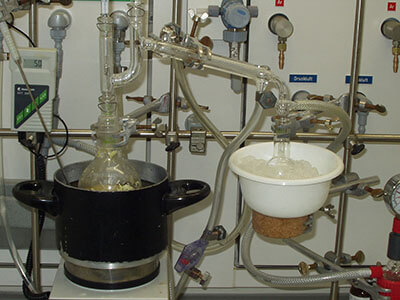This is a lesson summary. The full lesson can be viewed by purchasing an online course subscription.
Learning Objective
In this lesson we will learn how mixtures can be separated by a variety of methods, depending on the type of mixture and the physical properties of the component substances.
Learning Outcomes
By the end of this lesson you will be able to:
- Describe the following separation methods, with examples: decanting, sieving, filtration, separating funnel, centrifugation, magnetic separation, evaporation, distillation and chromatography.
- Define and identify: filtrate and residue, distillate, sediment and supernatant, mobile phase and stationary phase.
- Draw and label diagrams of the different separation methods.
- Determine the best method for separating common types of mixtures.

(Image: tippapatt, Adobe Stock)
Lesson Summary
- Since mixtures are formed by the physical combining of substances, they can also be physically separated.
- The most appropriate technique for separating a mixture depends on the type of mixture and the physical properties of the components.
- Separation techniques take advantage of differing physical properties between the components of a mixture, such as: melting and boiling point, size of fragments, solubility, density, magnetism and other forms of attraction.
- Separation techniques can be divided into those that involve the separation of heterogeneous mixtures and those that involve the separation of homogeneous mixtures.
- Decanting involves separating a liquid (supernatant) from a solid (sediment) by gently pouring off the liquid.
- Sieving involves separating a mixture based on different sizes of components, where smaller fragments pass through holes in the sieve but large fragments do not.
- Filtration is a special form of sieving where filter paper is used to trap very fine solid particles (residue) from the rest of a liquid or gas mixture (filtrate).
- Separating funnels or used for separating liquids with different densities.
- Centrifugation separates heterogeneous mixtures by spinning them at very high speeds, which forces components to separate into layers.
- Magnetism can be used for separating magnetic materials from non-magnetic materials.
- Evaporation is used for recovering dissolved substances from solutions by evaporating the solvent and crystallising the solute.
- Distillation involves the evaporation of a liquid (distillate), which is then cooled and condensed back into a liquid, to be collected separately.
- Chromatography separates mixtures based on their differing levels of attraction to two different substances, known as the mobile phase and the stationary phase.

(Image: Simon, Pixabay)
(Header image: mp_images, Adobe Stock)
